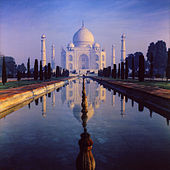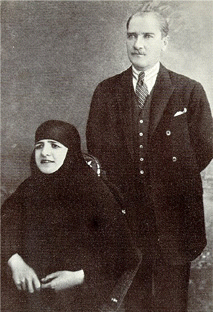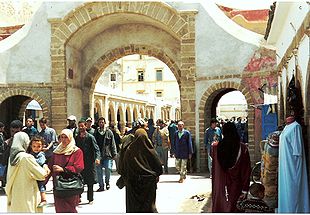Jilbāb
From Wikipedia, the free encyclopedia
| The neutrality of this article is disputed. Please see the discussion on the talk page. Please do not remove this message until the dispute is resolved. (December 2007) |
 Part of a series on |
|
|---|---|
| Architecture | |
|
Arabic · Azeri |
|
| Art | |
|
Calligraphy · Miniature · Rugs |
|
| Dance | |
| Dress | |
|
Abaya · Agal · Boubou |
|
| Holidays | |
|
Ashura · Arba'een · al-Ghadeer |
|
| Literature | |
|
Arabic · Azeri · Bengali |
|
| Islamic Martial Arts | |
| Music | |
| Dastgah · Ghazal · Madih nabawi |
|
| Theatre | |
The term jilbāb or jilbaab (Arabic جلباب) is the plural of the word jilaabah which refers to any long and loose-fit coat or garment worn by some Muslim women. They believe that this definition of jilbab fulfills the Quranic demand for a Hijab. Jilbab or Jilaabah is also known as Jubbah or Manteau (which is the French word for coat or mantle).
The modern jilbāb covers the entire body, except for hands, face, and head. The head and neck are then covered by a scarf or wrap (khimar). Some women will also cover the hands and face (niqab).
In Indonesia, the word jilbab is used for a headscarf rather than a long baggy overgarment (Geertz). In recent years, a short visor is often included to protect the face from the tropical sun.
Contents |
[edit] Qur'an and hadith
The plural of jilbāb, jalabib, is found in the Qur'an, verse 33:59 (Surah Al-Ahzab). The verse in transliterated Arabic and the popular translation of Yusuf Ali goes:
Ya ayyuha an-Nabiyy qul li azwajika wa banatika wa nisa al-mu'minin yudnina alayhinna min jalabib hinna; dhalika adna an yu'rafna fa laa yu'dhayn. Wa kana Allahu Ghafur Rahim
O Prophet! Tell thy wives and daughters, and the believing women, that they should cast their [jalabib] (Jilbabs) over their persons (when abroad): that is most convenient, that they should be known (as such) and not molested. And Allah is Oft-Forgiving, Most Merciful.
Whereas Yusuf Ali is not an accredited scholar of Qur'anic exegesis, Hadith (oral traditions of the Prophet Muhammad later recorded by contemporaries of his companions), or in any other religious field by any Islamic standard (by Islamic scholars of institutions such as al-Azhar of Egypt, Dar ul-Uloom of Pakistan and India, Islamic University of Saudi-Arabia, etc.), the translation of the Qur'an entitled Interpretation of the Meanings of the Noble Qur'an in the English Language by Dr. Muhammad Muhsin Khan and Dr. Muhammad Taqiuddin Al-Hilali is a better representation of Sunni thought as its meanings are taken from the books considered most authentic and accepted by all Sunnis, such as Tafsir Al-Tabari, Al-Qurtubi, Tafsir Ibn Kathir, and from the sound books of Hadith, Sahih Bukhari and Sahih Muslim. It is certified to this extent by Shaykh 'Abdul 'Aziz bin 'Abdullah bin Baz and Shaykh Umar Muhammad Fullata, two scholars of renown throughout the Sunni world during the latter half of the twentieth century who also represent two of the most prominent institutions of Sunni Islamic scholarship, Dar ul-Ifta in Riyadh, Saudi-Arabia and Islamic University of Al-Madinah Al-Munawwarah in Medina, Saudi-Arabia.
Its translation is as follows:
O Prophet! Tell your wives and your daughters and the women of the believers to draw their cloaks (jalabib or veils) all over their bodies (i.e. screen themselves completely except the eyes or one eye to see the way). That will be better, that they should be known (as free respectable women) so as not to be annoyed. And Allah is Ever Oft-Forgiving, Most Merciful.[3]
[3] (V.33:59) "They should cover (draw their veils (jalabib) over) their bodies, faces, necks and bosoms, etc., not to reveal their adornment."
This translation, "screen themselves completely except the eyes or one eye to see the way" is specifically from: Tafsir Al-Tabari, Vol. 22, page 33 and Tafsir Ibn Kathir, Vol. 6, page 471. This is also cited in the most senior tafsir (commentary of the Qur'an) of all, Tafsir Ibn Abbas, page 407, the edition published by Darul Fikr of Beirut, Lebanon. Ibn Abbas has the status of Sahaba, or companion of the Prophet.
There are hadith which serve as commentary on the above verse of the Qur'an (33:59) which mention the jilbab, such as the following:
Narrated Safiyah bint Shaibah: 'Aisha used to say: "When (the Verse): "They should draw their jalabib over their necks and bosoms," was revealed, (the ladies) cut their waist sheets at the edges and covered their faces with the cut pieces." (Sahih Bukhari, Volume 6, Book 60, Number #282)
Another hadith mentioning the jilbab follows:
Narrated Umm Atiyya: We were ordered to bring out our menstruating women and screened women to the religious gatherings and invocation of the Muslims on the two Eid festivals. These menstruating women were to keep away from the musalla. A woman asked, "O Messenger of Allah! What about one who does not have a jilbab?". He said, "Let her borrow the jilbab of her companion". (Sahih Bukhari, Book 8, #347)
[edit] Controversy

Since there are no pictures of 7th century jilbab, nor any surviving garments, it is not at all clear if the modern jilbab is the same garment as that referred to in the Qur'an. In general terms, jilbab is a garment/sheet that is worn on the head, draped around the body and that totally covers the body of the woman.
Some modern Muslims insist that the contemporary jilbab and the garment described in the Qur'an and the hadith are exactly the same, and that the Qur'an therefore requires the believer to wear 'these' garments.
Fadwa El Guindi, an Egyptian professor of anthropology, however argues that the jilbab and khimar worn today date only from the 1970s, when Egyptian women who belonged to the Muslim Brotherhood adopted them as Islamic dress.[citation needed] Wearing a jilbab advertised the wearer's adherence to a particular interpretation of Islam.
The Encyclopedia of Islam identifies over a hundred terms for dress parts, many of which are used for "veiling" (Encyclopedia of Islam 1986: 745–6). Some of these and related Arabic terms are burqu, ‘abayah, tarhah, bumus, jilbab, jellabah, hayik, milayah, gallabiyyah, dishdasha, gargush, gins’, mungub, lithma, yashmik, habarah, izar. A few terms refer to items used as face covers only. These are qina, burqu, niqab, lithma. Others refer to headcovers that are situationally held by the individual to cover part of the face. These are khimar, sitara, abayah or inrrah. (El Guindi 1999 p. 7)
Traditional Islamic costume for women seems to have included the abaya, the chador, and the burqa, as well as many other forms of dress and headcovering.
[edit] Sports wear
A new type of athletic jilbab has been developed by Nike.[1] This allows women to play volleyball while still respecting a traditional clothing style.[2]
[edit] References
- El Guindi, Fadwa -- Veil: Modesty, Privacy, and Resistance, Berg, 1999
- Geertz, Clifford -- Available Light: Anthropological Reflections on Philosophical Topics, Princeton University Press, 2000
[edit] Links
[edit] Notes
[edit] See also
|
|||||||||||

